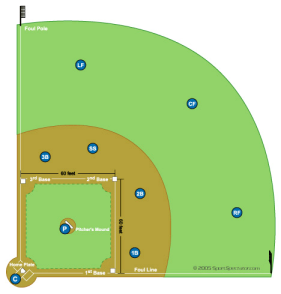Introduction
Softball is a direct descendant of baseball. Some key differences between softball and baseball are that softballs are larger than baseballs, and pitches are thrown underhand rather than overhand. Softball is played on a smaller diamond with a softer ball. For a softball field, the average distance from home plate to center field is 220 ft and from home plate to right and left field is about 200 ft. For a baseball field, the average distance from home plate to center is 410 ft and from home plate to right and left field is about 375 feet.
Court
The playing field is divided into fair territory and foul territory. Fair territory is further divided into the infield, the outfield, and the territory beyond the outfield fence.The field is defined by foul lines that meet at a right angle at home plate. The minimum length of the baselines varies classification of play (see below for official measurements). A fence running between the baselines defines the limits of the field; this fence is equidistant from home plate at all points.
Behind home plate is a backstop. It must be between 25 and 30 feet (7.62 and 9.14 meters) behind home plate depending on the type of division that is playing.
Equipment
Equipment required in softball includes a ball, a bat, gloves, uniforms and protective tools including helmets for the offensive team and a helmet, shin guards and chest protector for the defensive catcher.- Ball The size of the ball varies according to the classification of play; the permitted circumferences in international play are 12±0.125 in (30.5±0.3 cm), in weight between 6.25 oz (178 g) and 7.0 oz (198.4 g) in fast pitch; 11±0.125 in (29.7±0.3 cm), weight between 5.875 oz (166.5 g) and 6.125 oz (173.6 g) in slow pitch. A 12-inch circumference ball is generally used in slow pitch. Some balls have a raised seam and others do not. The ball is often covered in white or yellow leather in two pieces roughly the shape of a figure-8 and sewn together with red thread, although other coverings are permitted. The core of the ball may be made of long fiber kapok, or a mixture of cork and rubber, or a polyurethane mixture, or another approved material.
- Bat The bat used by the batter is made of metal, wood or composite materials (carbon fiber, etc.). Sizes may vary. In fast pitch softball, wooden bats are not allowed.
- Gloves All defensive players wear fielding gloves made of leather or similar material. Gloves have webbing between the thumb and forefinger known as the "pocket". The first baseman and the catcher may wear mitts; mitts are distinguished from gloves in that they have extra padding and no fingers. In 2007, ASA and other organizations revised their rules regarding gloves and mitts. The rules allow any player to use a glove or mitt. No part of the glove is allowed to be the same color as that of the ball including that of its seams
- Uniform Each team wears distinctive uniforms. The uniform includes a cap, visor, a shirt, an undershirt, tight sliding undershorts, socks, and shorts or pants; these are the components for which standards are set. At the back of the uniform an Arabic numeral from 1-99 must be visible. Numbers such as 02 and 2 are considered identical. Players' names are optional. All players are required to wear shoes. They may have cleats or spikes. The spikes must extend less than 0.75 inch (19 mm) away from the sole. Rounded metal spikes are illegal, as are ones made from hard plastic or other synthetic materials. High school athletes are sometimes permitted to wear metal cleats.
- Protective equipment All batters in fast pitch are required to wear batting helmets.Batting helmets must have two ear flaps, one on each side. Helmets and cages that are damaged or altered are forbidden. In fast pitch, the catcher must wear a protective helmet with a face-mask and throat protector. A female catcher may optionally wear a body protector in slow pitch. In fast pitch shin guards and helmets with face-mask's are required. Shin guards also protect the kneecap. In any form of softball, any player (other than fast pitch catchers on defense) can wear a protective face mask or face guard. As usual, it must be in proper condition and not damaged, altered, or the like. This is intended to prevent facial injuries.
